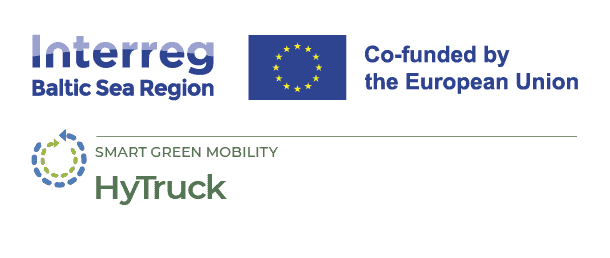
International transport accounts for about a quarter (24.8%) of the total volume of road freight transport in the EU and 6% of the total EU CO2 emissions.
Large trucks, which have to cover long distances, are mostly used in international transport. Many transporters and truck manufacturers believe that battery electric vehicles are not suitable for these requirements (heavy battery weight and long charging time or short driving distances). They believe that fuel cells have advantages in this area. Fuel cell trucks require hydrogen (H2) fuel and a comprehensive network of refueling stations.
The current proposal for an EU Regulation for the deployment of alternative fuels Infrastructure (AFIR)requires EU member states to ensure that a network of hydrogen filling stations is established along the main transport routes of the TEN-T network, located no further than 150 km from each other, by the end of 2030 .
Creating such a filling network requires a coordinated system (technology, payment system, security, etc.) that can only be sensibly created through international cooperation. Standardization from the start can eliminate the incompatibility problems that e-charging stations faced in the beginning.
| Programme |
Interreg Baltic Sea Region 2021-2027 |
| Partners |
1. Ministry of Economics, Infrastructure, Tourism and Labour Mecklenburg-Vorpommern (Germany) – Lead Partner
2. Ministry of Transport and Communications of the Republic of Lithuania (Lithuania)
3. Polish Alternative Fuels Association (Poland)
4. Vidzeme Planning Region (Latvia)
5. University of Tartu (Estonia)
6. Chalmers University of Technology (Sweden)
7. Reiner Lemoine Institut gGmbH (Germany)
8. Localiser RLI GmbH (Germany)
9. CLIC Innovation Ltd (Finland) |
| Associated Organisations |
1. H2 MOBILITY Deutschland GmbH & Co.KG (Germany)
2. PKN Orlen S.A. (Poland)
3. P2X Solutions Ltd (Finland)
4. GP JOULE Hydrogen GmbH (Germany)
5. Ministry of Economic Affairs and Communications (Estonia)
6. Ministry of Transport and Communications (Finland)
7. Ministry of Transport and Communications (Germany)
8. Ministry of Justice, European Affairs and ConsumerProtection of Land Schleswig-Holstein (Germany) |
| Objectives |
The objective of HyTruck is to support public authorities in steering the development of a network of hydrogen refuelling stations (HRS) suited for large trucks in the Eastern part of the North Sea-Baltic TEN-T corridor with harmonised standards across borders.
HyTruck aims at solutions enabling public authorities to address all relevant (spatial, economic, environmental and technological) dimensions when planning HRS. |
| Activities and tasks in the project |
- Digital spatial planning toolkit – The toolkit will be a publicly accessible component-based web application that shall be available via the one-stop-shop. It consists of a spatial database, a virtual H2 marketplace and an interactive web-based map with analytical GIS functions to support the planning process;
- Over-arching assessment model for HRS planning - It allows the techno-economic assessments focusing on comparing different hydrogen production options as well as hydrogen distribution alternatives including large centralized facilities vs decentralized onsite production. The model also includes an environmental life-cycle assessment for the different options. It supports the planner in finding the best possible combination between maximum environmental benefit (measured in CO2 savings potential) and the most cost-effective H2 supply options for fuel cell trucks;
- Proposals for common technological standards to ensure that the system can be used in any country without restrictions;
- Guideline for public authorities "Roadmap to planning HRS infrastructure” to ensure that public authorities will be able to streamline their undertakings and integrate their local infrastructure developments into the transnational context;
- Regional pilot implementation plans – it is planned to have five regional pilot implementation plans; preparatory research activities will be done to develop a spatial planning concept for locate HRS in five regions in five different countries - Germany, Poland, Lithuania, Latvia, Finland;
- Five spatial planning concepts will be developed • Rostock Region in DE • Poznan Region in PL • Kaunas Region in LT • Vidzeme Region in LV •Helsinki Region in FI. The spatial planning concepts for each pilot region serve to determine the locations for HRS and to lay foundation for a comprehensive HRS infrastructure in the BSR. The starting points for the pilot projects are cities that form urban nodes in the TEN-T corridors;
- One-stop shop for HRS – it is planned to create a joint internet platform for stakeholders from the transport sector, H2 producers and filling station operators, academia & public sector that goes beyond the HyTruck project. Cooperation with two already existing and well established network structures STRING and Scandria Alliance is planned;
- Input to national and transnational funding and policy programmes.
- Transnational exchange channel on HRS; organization of informative seminars and international conference.
|
| Results |
- Joint elaboration of BSR-wide protocol of technological standards and Proposal for common technological standards to determine optimal location for HRS in BSR;
- Signed Memorandum of understanding on harmonized technological standards for HRS;
- Guideline for public authorities: “Roadmap to planning HRS infrastructure”;
- One-stop shop for HRS;
- Improved knowledge of local municipalities, entrepreneurs and society about alternative fuel.
|
| Budget |
Total budget 2 557 583, 20 EUR
Vidzeme Planning Region 274 600, 00 EUR |
| Implementation period |
01.01.2023-31.12.2025 |
| Website |
https://interreg-baltic.eu/project/hytruck/ |
| Contacts |
Rita Merca (project manager in Vidzeme Planning Region)
Rita.merca@vidzeme.lv
Phone +371 29476373 |
read more...




